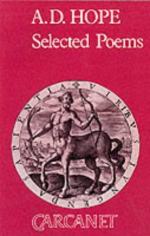|
This section contains 4,638 words (approx. 16 pages at 300 words per page) |

|
SOURCE: Wallace-Crabbe, Chris. “True Tales and False Alike Work by Suggestion: The Poetry of A. D. Hope.” Australian Literary Studies 14, no. 4 (October 1990): 415-24.
In the following essay, Wallace-Crabbe argues that Hope's poetry resists easy categorizations and investigates the poet's relationship to symbolism.
Attempts to characterise A. D. Hope's poetry fail very frequently because of a common tendency to see his oeuvre holistically. Simple caricatures emerge, portraying him in bold strokes as neoclassical, parnassian, art nouveau, anti-modernist, remorselessly iambic or whatever. All such categorisations underplay the extent to which Hope's poetry is strategically restless and subversive. The old tales he tells are nearly always undermined. The commonly bland critical prose sorts oddly with the poetic violence: indeed, much of his suaver criticism seems remote from the feminist high spirits of A Midsummer Eve's Dream. And the physical density of his compressed narratives is held with difficulty and at some...
|
This section contains 4,638 words (approx. 16 pages at 300 words per page) |

|


